UNITED STATES
SECURITIES AND EXCHANGE COMMISSION
Washington, D.C. 20549
SCHEDULE 14A
Proxy Statement Pursuant to Section 14(a) of the
Securities Exchange Act of 1934
Filed by the Registrant ☐ Filed by a party other than the Registrant ☒
Check the appropriate box:
| | |
| ☐ | | Preliminary Proxy Statement |
| |
| ☐ | | Confidential, for Use of the Commission Only (as permitted by Rule 14a-6(e)(2)) |
| |
| ☐ | | Definitive Proxy Statement |
| |
| ☐ | | Definitive Additional Materials |
| |
| ☒ | | SolicitingMaterialPursuanttoSection240.14a-12 |
Mentor Graphics Corporation
(Name of Registrant as Specified In Its Charter)
Siemens Aktiengesellschaft
(Name of Person(s) Filing Proxy Statement, if other than the Registrant)
Payment of Filing Fee (Check the appropriate box):
| | | | |
| |
| ☒ | | No fee required. |
| |
| ☐ | | Fee computed on table below per Exchange Act Rules 14a-6(i)(1) and 0-11. |
| | |
| | (1) | | Title of each class of securities to which transaction applies: |
| | (2) | | Aggregate number of securities to which transaction applies: |
| | (3) | | Per unit price or other underlying value of transaction computed pursuant to Exchange Act Rule 0-11 (set forth the amount on which the filing fee is calculated and state how it was determined): |
| | (4) | | Proposed maximum aggregate value of transaction: |
| | (5) | | Total fee paid: |
| |
| ☐ | | Fee paid previously with preliminary materials: |
| |
| ☐ | | Check box if any part of the fee is offset as provided by Exchange Act Rule 0-11(a)(2) and identify the filing for which the offsetting fee was paid previously. Identify the previous filing by registration statement number, or the Form or Schedule and the date of its filing. |
| | |
| | (1) | | Amount previously paid: |
| | (2) | | Form, Schedule or Registration Statement No.: |
| | (3) | | Filing party: |
| | (4) | | Date Filed: |
A copy of the transcript from a combined analyst and press call conducted by Siemens Aktiengesellschaft is attached hereto.
IMPORTANT INFORMATION ABOUT THE TRANSACTION:
This document contains statements related to our future business and financial performance and future events or developments involving Siemens that may constitute forward-looking statements. These statements may be identified by words such as “expect,” “look forward to,” “anticipate,” “intend,” “plan,” “believe,” “seek,” “estimate,” “will,” “project” or words of similar meaning. We may also make forward-looking statements in other reports, in presentations, in material delivered to shareholders and in press releases. In addition, our representatives may from time to time make oral forward-looking statements. Such statements are based on the current expectations and certain assumptions of Siemens’ management, and are, therefore, subject to certain risks and uncertainties. A variety of factors, many of which are beyond Siemens’ control, affect Siemens’ operations, performance, business strategy and results and could cause the actual results, performance or achievements of Siemens to be materially different from any future results, performance or achievements that may be expressed or implied by such forward- looking statements or anticipated on the basis of historical trends. These factors include in particular, but are not limited to, the matters described in the chapter Risks of our most recent annual report prepared in accordance with the German Commercial Code, and in the chapter Risks and opportunities of our most recent interim report. Further information about risks and uncertainties affecting Siemens is included throughout our most recent annual and interim reports, as well as our most recent earnings release, which are available on the Siemens website. Should one or more of these risks or uncertainties materialize, or should underlying assumptions prove incorrect, actual results, performance or achievements of Siemens may vary materially from those described in the relevant forward-looking statement as being expected, anticipated, intended, planned, believed, sought, estimated or projected. Siemens neither intends, nor assumes any obligation, to update or revise these forward-looking statements in light of developments which differ from those anticipated.
Mentor Graphics Corporation has filed with the Securities and Exchange Commission (“SEC”) a Current Report on Form 8-K, which contains, among other things, a copy of the merger agreement. In connection with the proposed merger, Mentor Graphics Corporation will prepare a proxy statement to be filed with the SEC that will provide additional important information concerning the proposed merger. When completed, a definitive proxy statement will be mailed to the stockholders of Mentor Graphics Corporation. Mentor Graphics Corporation and its respective directors, officers and employees and Siemens and its managing board, officers and employees may be deemed, under SEC rules, to be participants in the solicitation of proxies from Mentor Graphics Corporation stockholders in connection with the proposed merger. Mentor Graphics Corporation stockholders may obtain more detailed information regarding such persons by reading the proxy statement and other relevant materials filed with the SEC and, with respect to Siemens, certain relevant materials prepared in accordance with the German Commercial Code. MENTOR GRAPHICS CORPORATION STOCKHOLDERS ARE STRONGLY ADVISED TO READ ALL RELEVANT DOCUMENTS FILED WITH THE SEC, INCLUDING MENTOR GRAPHICS CORPORATION’S PROXY STATEMENT, BECAUSE THEY WILL CONTAIN IMPORTANT INFORMATION ABOUT THE PROPOSED TRANSACTION. Mentor Graphics Corporation’s stockholders will be able to obtain, without charge, a copy of the proxy statement (when available) and other relevant documents filed with the SEC from the SEC’s website at www.sec.gov. Mentor Graphics Corporation’s stockholders will also be able to obtain, without charge, a copy of the proxy statement and other documents relating to the proposed merger (when available) at www.mentor.com.

PGi
Siemens Combined Analyst and Press Conference Call
Company: Siemens AG
Conference Title: Siemens Combined Analyst and Press Conference Call
Moderator: Sabine Reichel
Date: Monday 14th November 2016
Operator: Please stand by, we’re about to begin. Good afternoon ladies and gentlemen, and welcome to the Siemens Combined Analyst and Press Conference Call. As a reminder this call is being recorded. Before we begin I would like to draw your attention to the safe harbor statement on page two of the Siemens presentation. This conference call may include forward-looking statements. These statements are based on the company’s current expectations and certain assumptions, and therefore subject to certain risks and uncertainties. At this time, I would like to turn the call over to your host today Sabine Reichel, head of Investor Relations. Please go ahead Madame.
Sabine Reichel: Good afternoon ladies and gentlemen and thank you for joining us on our
Combined Analyst and Press Call, regarding the acquisition of Mentor Graphics on short notice.
The press release, and also the presentation, were released earlier today. As always, you can download the files on our website. Today our CFO, Ralf Thomas, and Chuck Grindstaff, Executive Chairman of Siemens PLM Software, are on this call to review the announcement. Afterwards we will have time for Q&A with Ralf and Chuck. We will answer the questions from analysts and also from journalists. Please note, therefore, this call is held in English. And with that, I would like to hand over to Ralf.
Ralf Thomas: Thank you Sabine. Good afternoon everyone, and thank you for joining us today on short notice for this call. We are very pleased to announce a transformational transaction with the signing of the agreement to acquire US-based Mentor Graphics for around $4.5 billion enterprise value. I call this a fair price for a great company in the software industry. The transaction is
Page | 1 Ref 5093047 14.11.2016
pgi.com

PGi
Siemens Combined Analyst and Press Conference Call
another cornerstone to successfully execute on our Vision 2020. We continuously strengthen our portfolio and drive growth through shaping the digital transformation. We have proven over the last 10 years that the vision of bringing software for the entire product lifecycle and automation together in the digital enterprise is creating customer and shareholder value.
After the initial step to acquire the PLM software company, UGS, back in 2007, we have added a number of important elements for design and simulation, such as LMS and CD-adapco to our portfolio. Our PL business has a proven track record to successfully integrate software companies and deliver the expected synergies on an ever-expanding customer base. The acquisition of Mentor Graphics is a fundamental milestone to complement our software offering and expand our leadership in the industrial digital enterprise.
Looking at the strategic imperatives of Siemens Vision 2020, the acquisition of Mentor Graphics is the perfect fit and it will boost our software revenues of €3.3 billion by around one third. Mentor Graphics is an established technology leader and pioneer in Electrical Design Automation or EDA software. The EDA segment is a fast-growing market with more than 7% and Mentor Graphics has a software-typical, high double-digit margin profile. In a nutshell, Mentor Graphics is offering software, enabling electronics to be designed, simulated and manufactured within products.
By adding these crucial capabilities, Siemens will be the first company to offer mechanical, thermal, electrical, electronic and embedded software design capabilities on a single, integrated platform. We believe this dramatically accelerates our product roadmap with true conversions across all domains. Our customers drive a paradigm shift towards more and more complex and smart, connected products, such as autonomous vehicles. This acquisition is our answer to this development and will create significant customer value. With this unique combination of software tools our customers are able to sell accelerate their innovation, drive production efficiencies and
Page | 2 Ref 5093047 14.11.2016
pgi.com
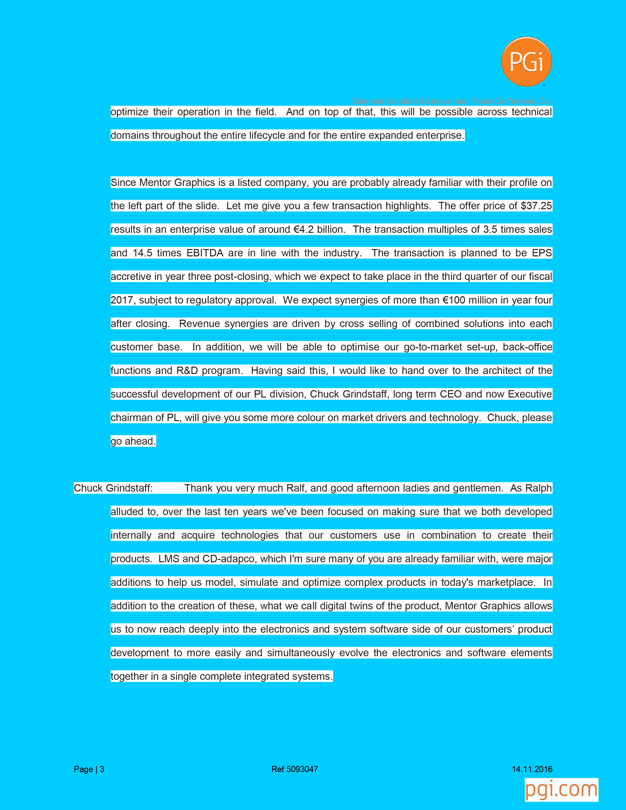
PGi
Siemens Combined Analyst and Press Conference Call
optimize their operation in the field. And on top of that, this will be possible across technical domains throughout the entire lifecycle and for the entire expanded enterprise.
Since Mentor Graphics is a listed company, you are probably already familiar with their profile on the left part of the slide. Let me give you a few transaction highlights. The offer price of $37.25 results in an enterprise value of around €4.2 billion. The transaction multiples of 3.5 times sales and 14.5 times EBITDA are in line with the industry. The transaction is planned to be EPS accretive in year three post-closing, which we expect to take place in the third quarter of our fiscal 2017, subject to regulatory approval. We expect synergies of more than €100 million in year four after closing. Revenue synergies are driven by cross selling of combined solutions into each customer base. In addition, we will be able to optimise our go-to-market set-up, back-office functions and R&D program. Having said this, I would like to hand over to the architect of the successful development of our PL division, Chuck Grindstaff, long term CEO and now Executive chairman of PL, will give you some more colour on market drivers and technology. Chuck, please go ahead.
Chuck Grindstaff: Thank you very much Ralf, and good afternoon ladies and gentlemen. As Ralph alluded to, over the last ten years we’ve been focused on making sure that we both developed internally and acquire technologies that our customers use in combination to create their products. LMS and CD-adapco, which I’m sure many of you are already familiar with, were major additions to help us model, simulate and optimize complex products in today’s marketplace. In addition to the creation of these, what we call digital twins of the product, Mentor Graphics allows us to now reach deeply into the electronics and system software side of our customers’ product development to more easily and simultaneously evolve the electronics and software elements together in a single complete integrated systems.
Page | 3
Ref 5093047
14.11.2016
pgi.com

PGi
Siemens Combined Analyst and Press Conference Call
We call the entire suite of tools our Digital Enterprise Software suite. We continue to be focused on our customers’ needs and on the open architecture of software that they require. And by that I mean our modular delivery of technology allows our customers to use our full Digital Enterprise Suite, as well as combine it together with components and elements from other market-leading companies around the world. This is important as Siemens has certainly the ability to optimize the connection between those domains but also is mindful of our customers’ complex IT environments.
If you move to the real change in today’s marketplace, the idea of complex –what we call mechatronics products. You see an automotive example and really across the entire car, not just an internal combustion vehicle but also electric vehicles, massive amount of electronics, software and intelligence is being placed deeply into the entire vehicle, whether it be entertainment, or something as simple as rain sensing systems, collision avoidance, all the way to autonomous driving. This transformation of intelligence of the various subsystems of the vehicle really benefits now, together with Mentor Graphics, because we can look at the entire mechanics, electronics and software as a system of systems that integrate together in the entire vehicle.
And it’s not just automotive. As you see on the next slide, the product segments that are applicable are really across all industrial applications, industrial equipment, infrastructure, telephones, even wearable technology and, of course, all facets of transportation. What we see are market drivers of higher levels of automation. Perhaps many of you are aware of the trend or a concept of the Internet of Things. And if you give a little bit of thought to how the Internet of Things actually works, its adding intelligence to the device is making them connected and that intelligence of the devices and the connectivity allows us to look at the entire collection of devices together to optimize performance of the fleet of operating devices, but also to feedback the closer loop with design and manufacturing.
Page | 4
Ref 5093047
14.11.2016
pgi.com
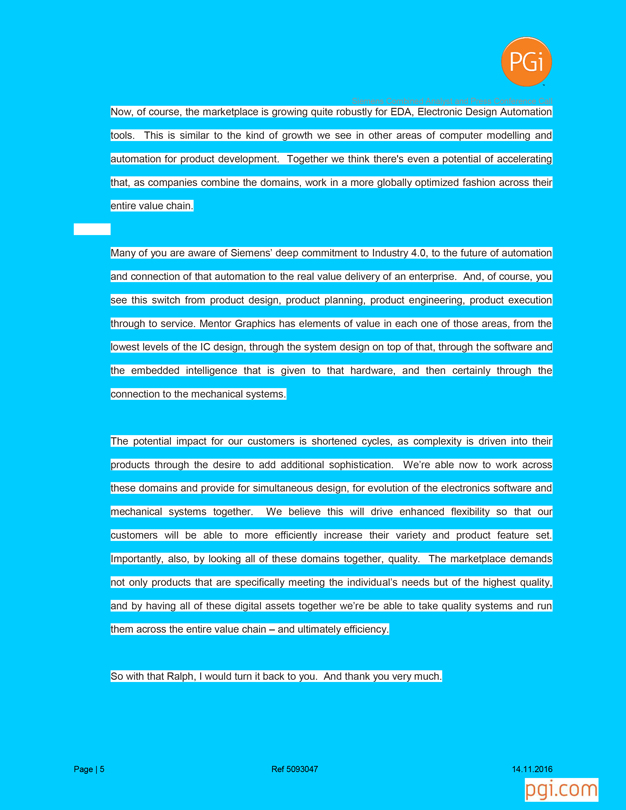
PGi
Siemens Combined Analyst and Press Conference Call
Now, of course, the marketplace is growing quite robustly for EDA, Electronic Design Automation tools. This is similar to the kind of growth we see in other areas of computer modelling and automation for product development. Together we think there’s even a potential of accelerating that, as companies combine the domains, work in a more globally optimized fashion across their entire value chain.
Many of you are aware of Siemens’ deep commitment to Industry 4.0, to the future of automation and connection of that automation to the real value delivery of an enterprise. And, of course, you see this switch from product design, product planning, product engineering, product execution through to service. Mentor Graphics has elements of value in each one of those areas, from the lowest levels of the IC design, through the system design on top of that, through the software and the embedded intelligence that is given to that hardware, and then certainly through the connection to the mechanical systems.
The potential impact for our customers is shortened cycles, as complexity is driven into their products through the desire to add additional sophistication. We’re able now to work across these domains and provide for simultaneous design, for evolution of the electronics software and mechanical systems together. We believe this will drive enhanced flexibility so that our customers will be able to more efficiently increase their variety and product feature set. Importantly, also, by looking all of these domains together, quality. The marketplace demands not only products that are specifically meeting the individual’s needs but of the highest quality, and by having all of these digital assets together we’re be able to take quality systems and run them across the entire value chain – and ultimately efficiency.
So with that Ralph, I would turn it back to you. And thank you very much.
Page | 5
Ref 5093047
14.11.2016
pgi.com
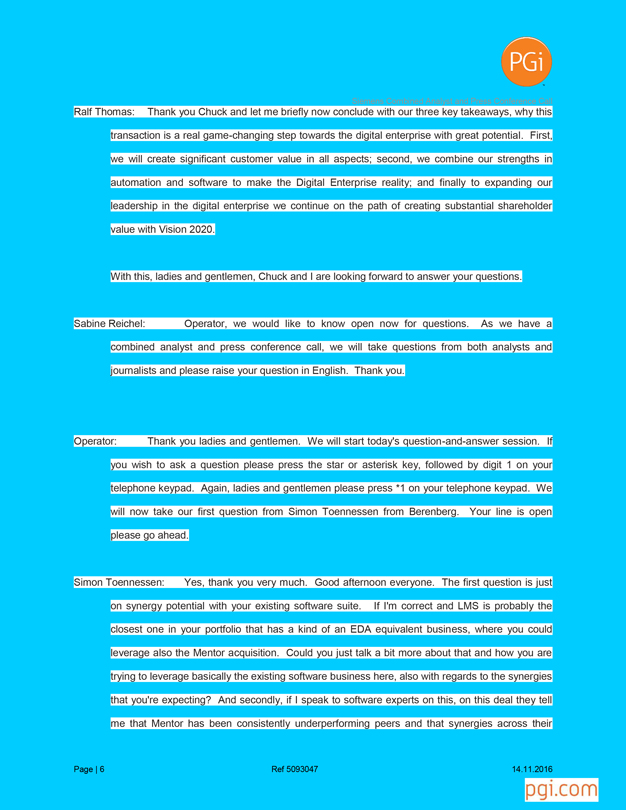
PGi
Siemens Combined Analyst and Press Conference Call
Ralf Thomas: Thank you Chuck and let me briefly now conclude with our three key takeaways, why this transaction is a real game-changing step towards the digital enterprise with great potential. First, we will create significant customer value in all aspects; second, we combine our strengths in automation and software to make the Digital Enterprise reality; and finally to expanding our leadership in the digital enterprise we continue on the path of creating substantial shareholder value with Vision 2020.
With this, ladies and gentlemen, Chuck and I are looking forward to answer your questions.
Sabine Reichel: Operator, we would like to know open now for questions. As we have a combined analyst and press conference call, we will take questions from both analysts and journalists and please raise your question in English. Thank you.
Operator: Thank you ladies and gentlemen. We will start today’s question-and-answer session. If you wish to ask a question please press the star or asterisk key, followed by digit 1 on your telephone keypad. Again, ladies and gentlemen please press *1 on your telephone keypad. We will now take our first question from Simon Toennessen from Berenberg. Your line is open please go ahead.
Simon Toennessen: Yes, thank you very much. Good afternoon everyone. The first question is just on synergy potential with your existing software suite. If I’m correct and LMS is probably the closest one in your portfolio that has a kind of an EDA equivalent business, where you could leverage also the Mentor acquisition. Could you just talk a bit more about that and how you are trying to leverage basically the existing software business here, also with regards to the synergies that you’re expecting? And secondly, if I speak to software experts on this, on this deal they tell me that Mentor has been consistently underperforming peers and that synergies across their
Page | 6
Ref 5093047
14.11.2016
pgi.com
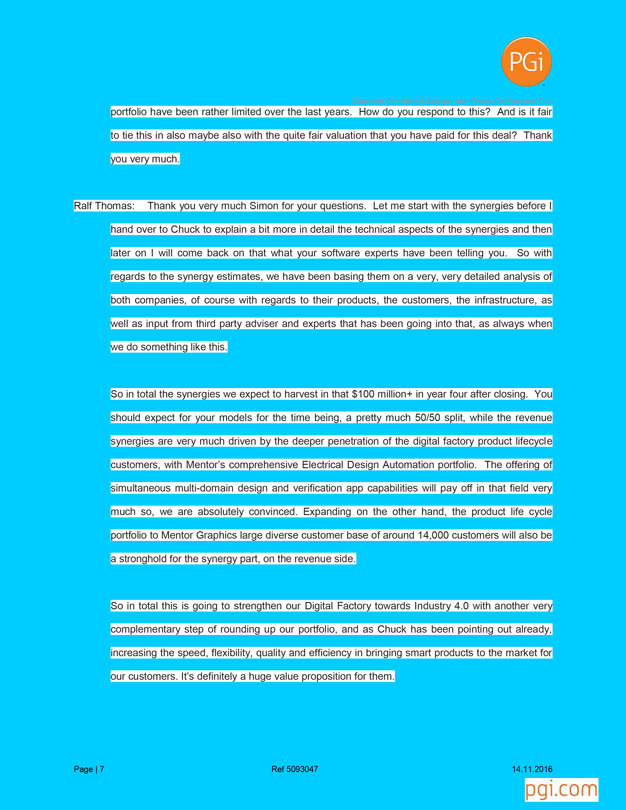
PGi
Siemens Combined Analyst and Press Conference Call portfolio have been rather limited over the last years. How do you respond to this? And is it fair to tie this in also maybe also with the quite fair valuation that you have paid for this deal? Thank
you very much.
Ralf Thomas: Thank you very much Simon for your questions. Let me start with the synergies before I hand over to Chuck to explain a bit more in detail the technical aspects of the synergies and then later on I will come back on that what your software experts have been telling you. So with regards to the synergy estimates, we have been basing them on a very, very detailed analysis of both companies, of course with regards to their products, the customers, the infrastructure, as well as input from third party adviser and experts that has been going into that, as always when we do something like this.
So in total the synergies we expect to harvest in that $100 million+ in year four after closing. You should expect for your models for the time being, a pretty much 50/50 split, while the revenue synergies are very much driven by the deeper penetration of the digital factory product lifecycle customers, with Mentor’s comprehensive Electrical Design Automation portfolio. The offering of simultaneous multi-domain design and verification app capabilities will pay off in that field very much so, we are absolutely convinced. Expanding on the other hand, the product life cycle portfolio to Mentor Graphics large diverse customer base of around 14,000 customers will also be a stronghold for the synergy part, on the revenue side.
So in total this is going to strengthen our Digital Factory towards Industry 4.0 with another very complementary step of rounding up our portfolio, and as Chuck has been pointing out already, increasing the speed, flexibility, quality and efficiency in bringing smart products to the market for our customers. It’s definitely a huge value proposition for them.
Page | 7
Ref 5093047
14.11.2016
pgi.com
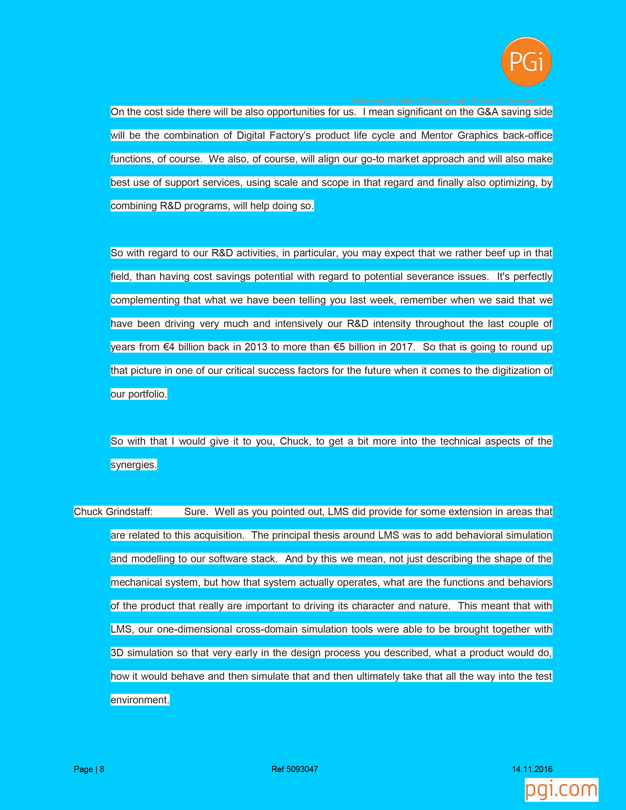
PGi
Siemens Combined Analyst and Press Conference Call
On the cost side there will be also opportunities for us. I mean significant on the G&A saving side will be the combination of Digital Factory’s product life cycle and Mentor Graphics back-office functions, of course. We also, of course, will align our go-to market approach and will also make best use of support services, using scale and scope in that regard and finally also optimizing, by combining R&D programs, will help doing so.
So with regard to our R&D activities, in particular, you may expect that we rather beef up in that field, than having cost savings potential with regard to potential severance issues. It’s perfectly complementing that what we have been telling you last week, remember when we said that we have been driving very much and intensively our R&D intensity throughout the last couple of years from €4 billion back in 2013 to more than €5 billion in 2017. So that is going to round up that picture in one of our critical success factors for the future when it comes to the digitization of our portfolio.
So with that I would give it to you, Chuck, to get a bit more into the technical aspects of the
synergies.
Chuck Grindstaff: Sure. Well as you pointed out, LMS did provide for some extension in areas that are related to this acquisition. The principal thesis around LMS was to add behavioral simulation and modelling to our software stack. And by this we mean, not just describing the shape of the mechanical system, but how that system actually operates, what are the functions and behaviors of the product that really are important to driving its character and nature. This meant that with LMS, our one-dimensional cross-domain simulation tools were able to be brought together with 3D simulation so that very early in the design process you described, what a product would do, how it would behave and then simulate that and then ultimately take that all the way into the test environment.
Page | 8
Ref 5093047
14.11.2016
pgi.com
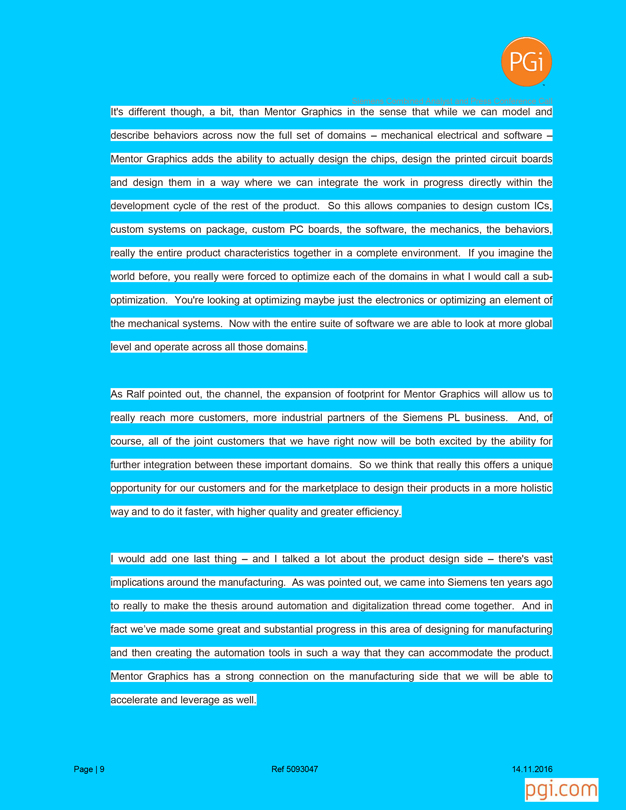
PGi
Siemens Combined Analyst and Press Conference Call
It’s different though, a bit, than Mentor Graphics in the sense that while we can model and describe behaviors across now the full set of domains – mechanical electrical and software –Mentor Graphics adds the ability to actually design the chips, design the printed circuit boards and design them in a way where we can integrate the work in progress directly within the development cycle of the rest of the product. So this allows companies to design custom ICs, custom systems on package, custom PC boards, the software, the mechanics, the behaviors, really the entire product characteristics together in a complete environment. If you imagine the world before, you really were forced to optimize each of the domains in what I would call a sub-optimization. You’re looking at optimizing maybe just the electronics or optimizing an element of the mechanical systems. Now with the entire suite of software we are able to look at more global level and operate across all those domains.
As Ralf pointed out, the channel, the expansion of footprint for Mentor Graphics will allow us to really reach more customers, more industrial partners of the Siemens PL business. And, of course, all of the joint customers that we have right now will be both excited by the ability for further integration between these important domains. So we think that really this offers a unique opportunity for our customers and for the marketplace to design their products in a more holistic way and to do it faster, with higher quality and greater efficiency.
I would add one last thing – and I talked a lot about the product design side – there’s vast implications around the manufacturing. As was pointed out, we came into Siemens ten years ago to really to make the thesis around automation and digitalization thread come together. And in fact we’ve made some great and substantial progress in this area of designing for manufacturing and then creating the automation tools in such a way that they can accommodate the product. Mentor Graphics has a strong connection on the manufacturing side that we will be able to accelerate and leverage as well.
Page | 9
Ref 5093047
14.11.2016
pgi.com
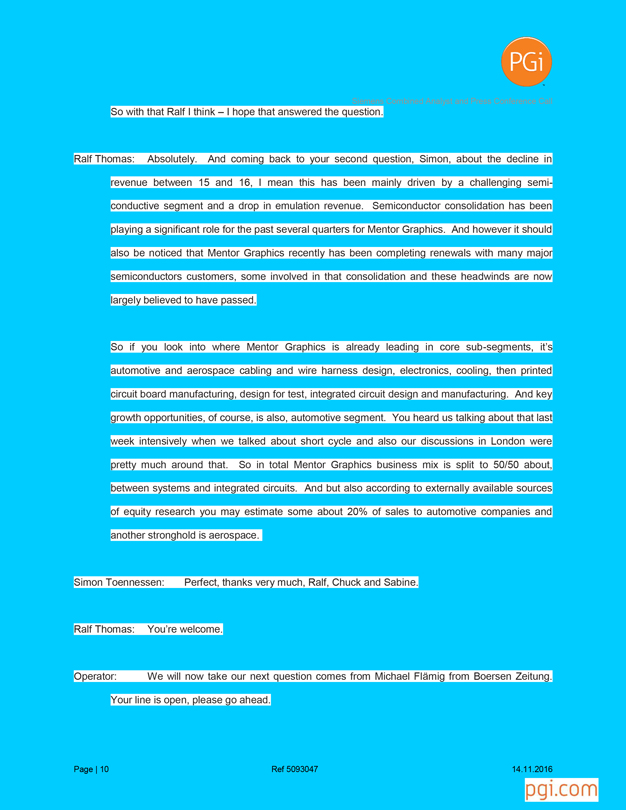
PGi
Siemens Combined Analyst and Press Conference Call
So with that Ralf I think – I hope that answered the question.
Ralf Thomas: Absolutely. And coming back to your second question, Simon, about the decline in revenue between 15 and 16, I mean this has been mainly driven by a challenging semiconductive segment and a drop in emulation revenue. Semiconductor consolidation has been playing a significant role for the past several quarters for Mentor Graphics. And however it should also be noticed that Mentor Graphics recently has been completing renewals with many major semiconductors customers, some involved in that consolidation and these headwinds are now largely believed to have passed.
So if you look into where Mentor Graphics is already leading in core sub-segments, it’s automotive and aerospace cabling and wire harness design, electronics, cooling, then printed circuit board manufacturing, design for test, integrated circuit design and manufacturing. And key growth opportunities, of course, is also, automotive segment. You heard us talking about that last week intensively when we talked about short cycle and also our discussions in London were pretty much around that. So in total Mentor Graphics business mix is split to 50/50 about, between systems and integrated circuits. And but also according to externally available sources of equity research you may estimate some about 20% of sales to automotive companies and another stronghold is aerospace.
Simon Toennessen: Perfect, thanks very much, Ralf, Chuck and Sabine.
Ralf Thomas: You’re welcome.
Operator: We will now take our next question comes from Michael Flämig from Boersen Zeitung.
Your line is open, please go ahead.
Page | 10
Ref 5093047
14.11.2016
pgi.com
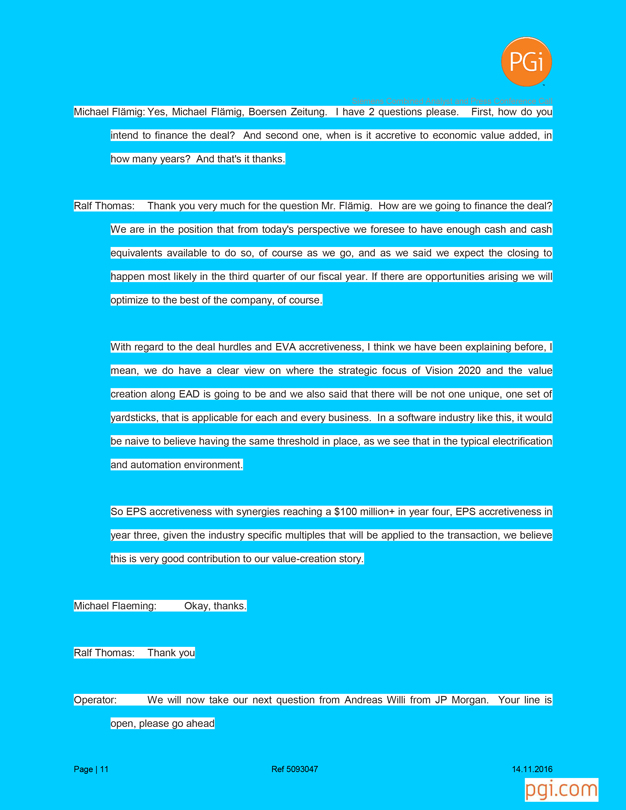
PGi
Siemens Combined Analyst and Press Conference Call
Michael Flämig: Yes, Michael Flämig, Boersen Zeitung. I have 2 questions please. First, how do you intend to finance the deal? And second one, when is it accretive to economic value added, in how many years? And that’s it thanks.
Ralf Thomas: Thank you very much for the question Mr. Flämig. How are we going to finance the deal? We are in the position that from today’s perspective we foresee to have enough cash and cash equivalents available to do so, of course as we go, and as we said we expect the closing to happen most likely in the third quarter of our fiscal year. If there are opportunities arising we will optimize to the best of the company, of course.
With regard to the deal hurdles and EVA accretiveness, I think we have been explaining before, I mean, we do have a clear view on where the strategic focus of Vision 2020 and the value creation along EAD is going to be and we also said that there will be not one unique, one set of yardsticks, that is applicable for each and every business. In a software industry like this, it would be naive to believe having the same threshold in place, as we see that in the typical electrification and automation environment.
So EPS accretiveness with synergies reaching a $100 million+ in year four, EPS accretiveness in year three, given the industry specific multiples that will be applied to the transaction, we believe this is very good contribution to our value-creation story.
Michael Flaeming: Okay, thanks.
Ralf Thomas: Thank you
Operator: We will now take our next question from Andreas Willi from JP Morgan. Your line is
open, please go ahead
Page | 11
Ref 5093047
14.11.2016
pgi.com
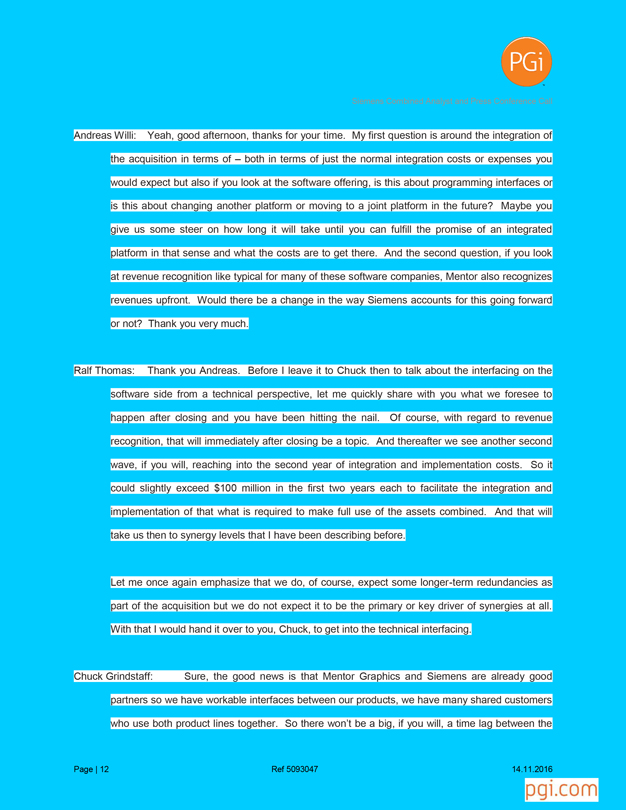
PGi
Siemens Combined Analyst and Press Conference Call
Andreas Willi: Yeah, good afternoon, thanks for your time. My first question is around the integration of the acquisition in terms of – both in terms of just the normal integration costs or expenses you would expect but also if you look at the software offering, is this about programming interfaces or is this about changing another platform or moving to a joint platform in the future? Maybe you give us some steer on how long it will take until you can fulfill the promise of an integrated platform in that sense and what the costs are to get there. And the second question, if you look at revenue recognition like typical for many of these software companies, Mentor also recognizes revenues upfront. Would there be a change in the way Siemens accounts for this going forward or not? Thank you very much.
Ralf Thomas: Thank you Andreas. Before I leave it to Chuck then to talk about the interfacing on the software side from a technical perspective, let me quickly share with you what we foresee to happen after closing and you have been hitting the nail. Of course, with regard to revenue recognition, that will immediately after closing be a topic. And thereafter we see another second wave, if you will, reaching into the second year of integration and implementation costs. So it could slightly exceed $100 million in the first two years each to facilitate the integration and implementation of that what is required to make full use of the assets combined. And that will take us then to synergy levels that I have been describing before.
Let me once again emphasize that we do, of course, expect some longer-term redundancies as part of the acquisition but we do not expect it to be the primary or key driver of synergies at all. With that I would hand it over to you, Chuck, to get into the technical interfacing.
Chuck Grindstaff: Sure, the good news is that Mentor Graphics and Siemens are already good partners so we have workable interfaces between our products, we have many shared customers who use both product lines together. So there won’t be a big, if you will, a time lag between the
Page | 12
Ref 5093047
14.11.2016
pgi.com
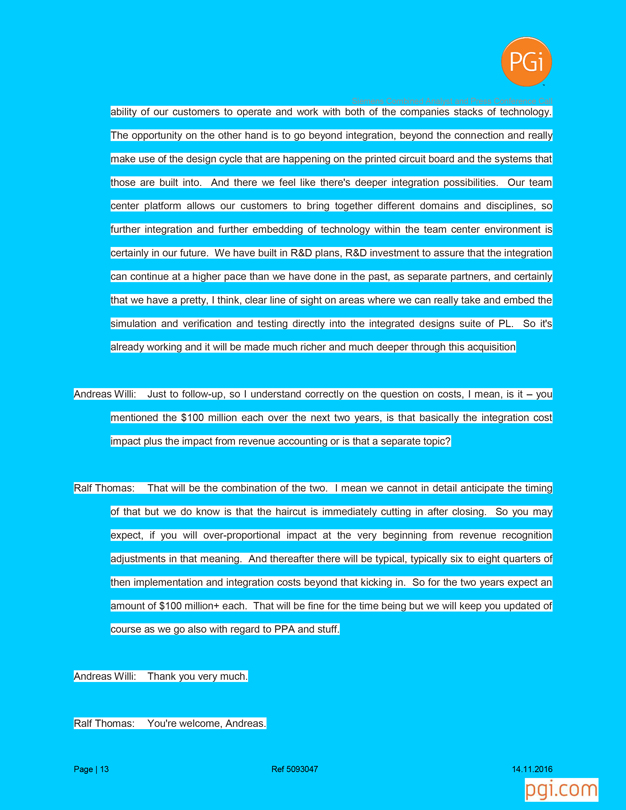
PGi
Siemens Combined Analyst and Press Conference Call
ability of our customers to operate and work with both of the companies stacks of technology.
The opportunity on the other hand is to go beyond integration, beyond the connection and really make use of the design cycle that are happening on the printed circuit board and the systems that those are built into. And there we feel like there’s deeper integration possibilities. Our team center platform allows our customers to bring together different domains and disciplines, so further integration and further embedding of technology within the team center environment is certainly in our future. We have built in R&D plans, R&D investment to assure that the integration can continue at a higher pace than we have done in the past, as separate partners, and certainly that we have a pretty, I think, clear line of sight on areas where we can really take and embed the simulation and verification and testing directly into the integrated designs suite of PL. So it’s already working and it will be made much richer and much deeper through this acquisition
Andreas Willi: Just to follow-up, so I understand correctly on the question on costs, I mean, is it – you mentioned the $100 million each over the next two years, is that basically the integration cost impact plus the impact from revenue accounting or is that a separate topic?
Ralf Thomas: That will be the combination of the two. I mean we cannot in detail anticipate the timing of that but we do know is that the haircut is immediately cutting in after closing. So you may expect, if you will over-proportional impact at the very beginning from revenue recognition adjustments in that meaning. And thereafter there will be typical, typically six to eight quarters of then implementation and integration costs beyond that kicking in. So for the two years expect an amount of $100 million+ each. That will be fine for the time being but we will keep you updated of course as we go also with regard to PPA and stuff.
Andreas Willi: Thank you very much.
Ralf Thomas: You’re welcome, Andreas.
Page | 13
Ref 5093047
14.11.2016
pgi.com
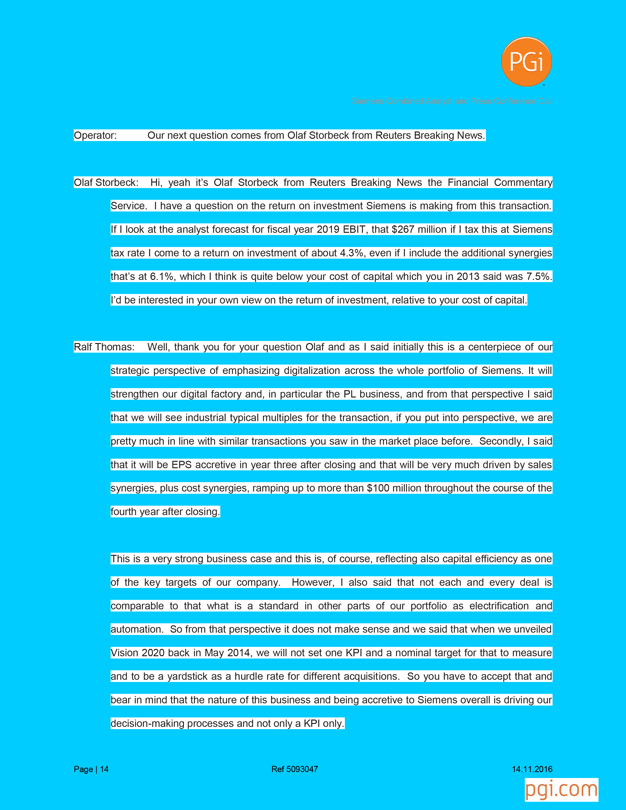
PGi
Siemens Combined Analyst and Press Conference Call
Operator: Our next question comes from Olaf Storbeck from Reuters Breaking News.
Olaf Storbeck: Hi, yeah it’s Olaf Storbeck from Reuters Breaking News the Financial Commentary
Service. I have a question on the return on investment Siemens is making from this transaction. If I look at the analyst forecast for fiscal year 2019 EBIT, that $267 million if I tax this at Siemens tax rate I come to a return on investment of about 4.3%, even if I include the additional synergies that’s at 6.1%, which I think is quite below your cost of capital which you in 2013 said was 7.5%. I’d be interested in your own view on the return of investment, relative to your cost of capital.
Ralf Thomas: Well, thank you for your question Olaf and as I said initially this is a centerpiece of our strategic perspective of emphasizing digitalization across the whole portfolio of Siemens. It will strengthen our digital factory and, in particular the PL business, and from that perspective I said that we will see industrial typical multiples for the transaction, if you put into perspective, we are pretty much in line with similar transactions you saw in the market place before. Secondly, I said that it will be EPS accretive in year three after closing and that will be very much driven by sales synergies, plus cost synergies, ramping up to more than $100 million throughout the course of the fourth year after closing.
This is a very strong business case and this is, of course, reflecting also capital efficiency as one of the key targets of our company. However, I also said that not each and every deal is comparable to that what is a standard in other parts of our portfolio as electrification and automation. So from that perspective it does not make sense and we said that when we unveiled Vision 2020 back in May 2014, we will not set one KPI and a nominal target for that to measure and to be a yardstick as a hurdle rate for different acquisitions. So you have to accept that and bear in mind that the nature of this business and being accretive to Siemens overall is driving our decision-making processes and not only a KPI only.
Page | 14
Ref 5093047
14.11.2016
pgi.com

PGi
Siemens Combined Analyst and Press Conference Call
Olaf Storbeck: Okay, thank you
Ralf Thomas: Thank you
Operator: Our next question comes from Gael deBray from Deutsche Bank, please go ahead.
Gael deBray: Thanks very much. A couple of questions please. Mentor Graphics’ revenue dropped
13% in the first half and I think the guidance is for about flat sales for the full year. So I mean, can you explain what is expected to drive the revenue rebound in the second half? And, in essence, are you happy with the current consensus expectations for Mentor this year and next? The second question is about the 20% margin you’re giving for the business. So how do you reconcile the 20% number with the lower margins that have been reported by Mentor last year? Thank you.
Ralf Thomas: Thank you, Gael, for your questions. First of all, I have to admit that at the moment we are just about – we have just been signing the deal and I’m not in a position to comment the performance of Mentor Graphics at the moment. So with regards to what extent they expect their revenue to bounce back second half of the year, and also to comment on the margin and development is not on me, not yet – we will come to that point, I’m sure. But, as I said, before our read on that, what we saw happening throughout the last couple of quarters, was that there was quite a challenging segment, business segment, on the semiconductor side having impact on their development. And also the drop in emulation revenue will – may have played a role. I have to say that I also take that from the publically available information from them.
Semiconductor consolidation, as such, has been playing a significant role over the past several quarters, not only for Mentor Graphics but in the whole industry; I think you would agree upon
Page | 15 Ref 5093047 14.11.2016
pgi.com

PGi
Siemens Combined Analyst and Press Conference Call
that. But I also mentioned that Mentor Graphics just recently has been completing renewals with
a couple of major semiconductor customers. And therefore, we believe that the headwinds are now largely passed in that field. I also have been elaborating I think quite broadly on the different sub-segments of the market in which Mentor Graphics does have strongholds, including automotive, which is still under a lot of positive momentum compared to other parts of the short-cycle industries, as we discussed that last week together. And there’s also a strong foothold for their aerospace business.
So I believe that should give you a framework in which you can sort in what our considerations have been, to believe in the way forward with regards to that what also the consensus is indicating.
Gael deBray: Okay, sorry what about the how we can reconcile the 20% sort of margin you mentioned?
Ralf Thomas: That’s a question you need to refer back to Mentor Graphics management for the time being, unfortunately.
Gael: deBray: Okay, okay, I’ll have a look thanks.
Ralf Thomas: Thank you.
Operator: As a reminder to ask a question please press *1 on your telephone keypad. We will now take our next question from Andre Kukhnin from Credit Suisse. Please go ahead.
Andre Kukhnin: Yes, good afternoon, and thanks for taking my questions. Firstly, just a few on the deal mechanics, could you share with us thinking behind timing, kind of why now and then whether it was competitive process at all? Is there a break-up fee? And then just more on mechanics, the
Page | 16 Ref 5093047 14.11.2016
pgi.com
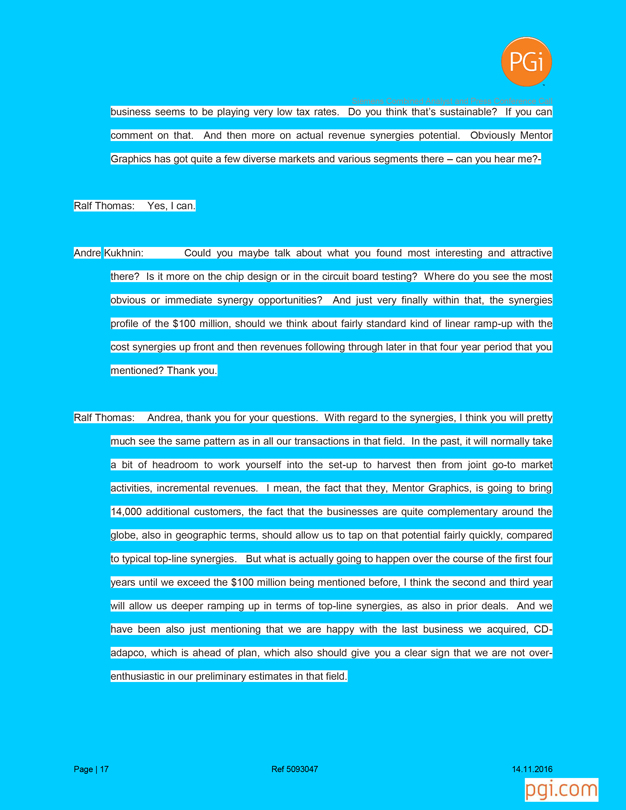
PGi
Siemens Combined Analyst and Press Conference Call
business seems to be playing very low tax rates. Do you think that’s sustainable? If you can comment on that. And then more on actual revenue synergies potential. Obviously Mentor Graphics has got quite a few diverse markets and various segments there – can you hear me?-
Ralf Thomas: Yes, I can.
Andre Kukhnin: Could you maybe talk about what you found most interesting and attractive there? Is it more on the chip design or in the circuit board testing? Where do you see the most obvious or immediate synergy opportunities? And just very finally within that, the synergies profile of the $100 million, should we think about fairly standard kind of linear ramp-up with the cost synergies up front and then revenues following through later in that four year period that you mentioned? Thank you.
Ralf Thomas: Andrea, thank you for your questions. With regard to the synergies, I think you will pretty much see the same pattern as in all our transactions in that field. In the past, it will normally take a bit of headroom to work yourself into the set-up to harvest then from joint go-to market activities, incremental revenues. I mean, the fact that they, Mentor Graphics, is going to bring 14,000 additional customers, the fact that the businesses are quite complementary around the globe, also in geographic terms, should allow us to tap on that potential fairly quickly, compared to typical top-line synergies. But what is actually going to happen over the course of the first four years until we exceed the $100 million being mentioned before, I think the second and third year will allow us deeper ramping up in terms of top-line synergies, as also in prior deals. And we have been also just mentioning that we are happy with the last business we acquired, CD-adapco, which is ahead of plan, which also should give you a clear sign that we are not over-enthusiastic in our preliminary estimates in that field.
Page | 17 Ref 5093047 14.11.2016
pgi.com

PGi
Siemens Combined Analyst and Press Conference Call
With regard to the content of the revenue synergies I will pass that on to Chuck in a minute but, in terms of the deal mechanics and the timing, I think we are on a very well and balanced trajectory in terms of speeding up our activities around the digital enterprise. And therefore I think it is an excellent point in time to get an additional catalyst in place for showing that we are really leading in this field and every leader is going ahead and is setting the pace, instead of reacting to competitor moves.
In terms of the terms and conditions of the contract, we will not share with you anything more than we have been distributing in the press statement so far. And in particular with regard to taxes, we first will have an intensive look into that what we find after closing and then also make transparent to you, as we did in the past, what potential and challenges we may see there but we looked into all the aspects and didn’t see any that would cause us any headaches. Chuck, would you talk a bit about the revenue synergy from a market point of view?
Chuck Grindstaff: Sure, yeah. I think, obviously, we’ve talked about a whole series of general areas of synergy but I guess I would highlight specifically Mentor’s long-term strategy that we found very attractive. What Mentor has been able to do in the area of design automation for integrated circuits, it has been embarked on bringing to the entire system level design. And what this means is that rather than having separate tools that do each element of the system, by working in a completely integrated fashion, Mentor’s strategy has been to invest and deliver a fully automated design, simulation, emulation, commissioning and manufacturing environment for the complete system, whether it’s printed circuit boards, whether its system-on-package – if you’re familiar with this technology, very highly, densely-packed electronics on what looks from the outside like a chip but inside is a very dense set of electronics and software.
So this strategy of doing the same thing in system design that has been accomplished in IC design is very attractive to us. And with our advanced R&D platform with our team center tools,
Page | 18 Ref 5093047 14.11.2016
pgi.com

PGi
Siemens Combined Analyst and Press Conference Call with our investment in R&D, we feel that we can help Mentor really accelerate that transformation and we think that this is an area that can tap into the over double-digit growth in the systems market.
Andre Kukhnin: That’s very helpful thank you very much. If I may, could I just ask a quick follow-up? In terms of Siemens’ existing semi-con exposure in digital factory, could you share with us any details on that, just thinking about if there’s potential to immediately cross-pollinate that with the relationships that Mentor Graphics has got?
Ralf Thomas: There is no material semiconductor involvement or exposure for the digital factory, as such, before the merger.
Andrea: Kukhnin: Got it, thank you very much.
Sabine Reichel: Operator we will take the next question. As far as I can see it’s analysts who have further questions. The press, of course, is very welcome to ask further the questions, so please press *1 to ask further questions, if needed. So thank you, next one.
Operator: James Stettler from Barclays, please go ahead.
James Stettler: Thank you and good afternoon all. Having spent roughly €9 billion since 2007, where do you now stand, and also including Bentley which was announced last week? I mean, what is now lacking in the platform or do you have really all the levers that you need? That’s question one.
And you obviously talk a lot about CD-adapco being ahead of schedule. If you now look back at UGS and LMS, can you talk about a bit what really came through in terms of sales and cost synergies and how that really developed versus plan? Thank you.
Page | 19 Ref 5093047 14.11.2016
pgi.com
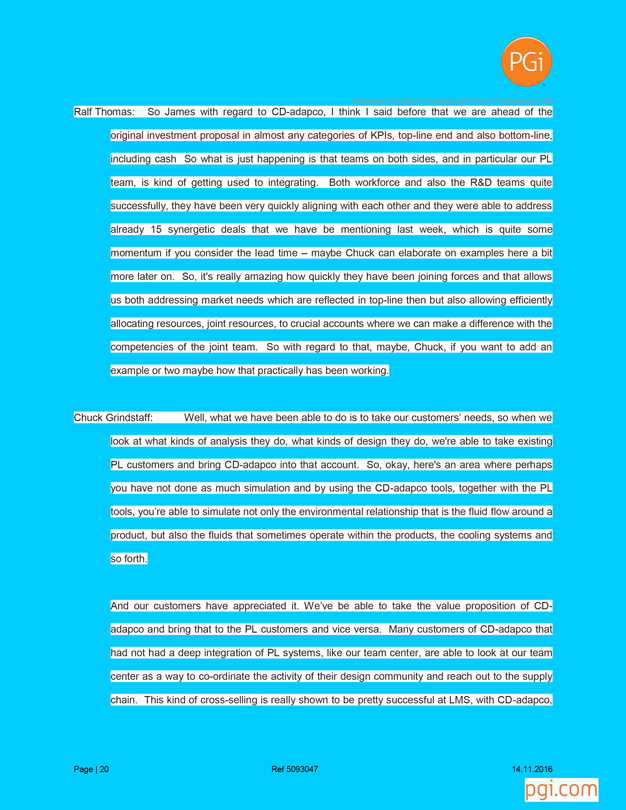
PGi
Siemens Combined Analyst and Press Conference Call
Ralf Thomas: So James with regard to CD-adapco, I think I said before that we are ahead of the original investment proposal in almost any categories of KPIs, top-line end and also bottom-line, including cash So what is just happening is that teams on both sides, and in particular our PL team, is kind of getting used to integrating. Both workforce and also the R&D teams quite successfully, they have been very quickly aligning with each other and they were able to address already 15 synergetic deals that we have be mentioning last week, which is quite some momentum if you consider the lead time – maybe Chuck can elaborate on examples here a bit more later on. So, it’s really amazing how quickly they have been joining forces and that allows us both addressing market needs which are reflected in top-line then but also allowing efficiently allocating resources, joint resources, to crucial accounts where we can make a difference with the competencies of the joint team. So with regard to that, maybe, Chuck, if you want to add an example or two maybe how that practically has been working.
Chuck Grindstaff: Well, what we have been able to do is to take our customers’ needs, so when we look at what kinds of analysis they do, what kinds of design they do, we’re able to take existing PL customers and bring CD-adapco into that account. So, okay, here’s an area where perhaps you have not done as much simulation and by using the CD-adapco tools, together with the PL tools, you’re able to simulate not only the environmental relationship that is the fluid flow around a product, but also the fluids that sometimes operate within the products, the cooling systems and so forth.
And our customers have appreciated it. We’ve be able to take the value proposition of CD-adapco and bring that to the PL customers and vice versa. Many customers of CD-adapco that had not had a deep integration of PL systems, like our team center, are able to look at our team center as a way to co-ordinate the activity of their design community and reach out to the supply chain. This kind of cross-selling is really shown to be pretty successful at LMS, with CD-adapco,
Page | 20 Ref 5093047 14.11.2016
pgi.com
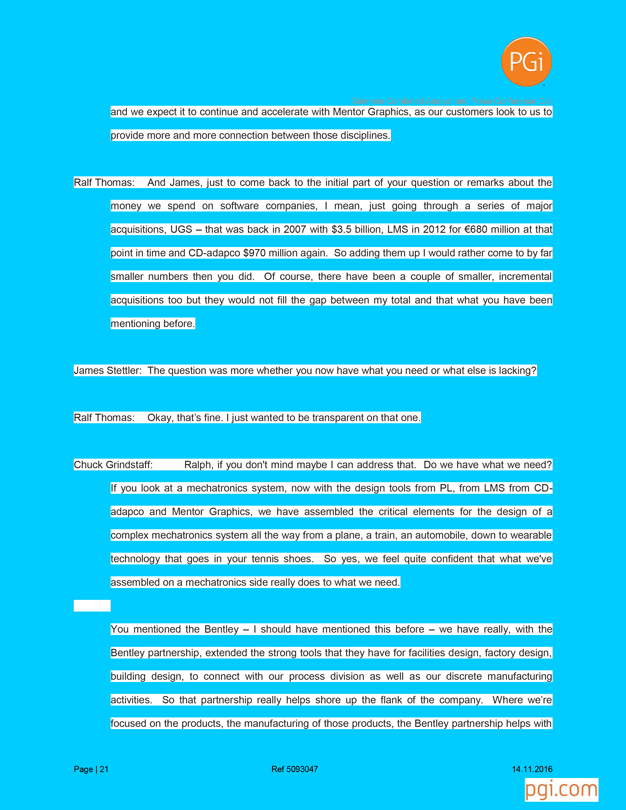
PGi
Siemens Combined Analyst and Press Conference Call and we expect it to continue and accelerate with Mentor Graphics, as our customers look to us to provide more and more connection between those disciplines.
Ralf Thomas: And James, just to come back to the initial part of your question or remarks about the money we spend on software companies, I mean, just going through a series of major acquisitions, UGS – that was back in 2007 with $3.5 billion, LMS in 2012 for €680 million at that point in time and CD-adapco $970 million again. So adding them up I would rather come to by far smaller numbers then you did. Of course, there have been a couple of smaller, incremental acquisitions too but they would not fill the gap between my total and that what you have been mentioning before.
James Stettler: The question was more whether you now have what you need or what else is lacking?
Ralf Thomas: Okay, that’s fine. I just wanted to be transparent on that one.
Chuck Grindstaff: Ralph, if you don’t mind maybe I can address that. Do we have what we need? If you look at a mechatronics system, now with the design tools from PL, from LMS from CD-adapco and Mentor Graphics, we have assembled the critical elements for the design of a complex mechatronics system all the way from a plane, a train, an automobile, down to wearable technology that goes in your tennis shoes. So yes, we feel quite confident that what we’ve assembled on a mechatronics side really does to what we need.
You mentioned the Bentley – I should have mentioned this before – we have really, with the Bentley partnership, extended the strong tools that they have for facilities design, factory design, building design, to connect with our process division as well as our discrete manufacturing activities. So that partnership really helps shore up the flank of the company. Where we’re focused on the products, the manufacturing of those products, the Bentley partnership helps with
Page | 21 Ref 5093047 14.11.2016
pgi.com

PGi
Siemens Combined Analyst and Press Conference Call
the design of the environment around those products; the factories, the buildings and
infrastructure to stand up in order to support that.
James Stettler: Great, thank you.
Operator: Our next question comes from Jens Hack from Reuters; please go ahead.
Jens Hack: Hello gentlemen, just two questions. How big is the share that Mentor makes with Semis and how big is the share with other industries? And the second one, you left the semiconductor business about 15, 16 years ago. What is the reason for re-entering this market again? Thank you.
Ralf Thomas: Thank you for your questions, Jens. First of all of all, we are not re-entering the sector again. What we do is we provide opportunities for semiconductor production companies to be more efficient in their field. If you like, Chuck, you can maybe elaborate a bit on that in a minute.
And with regards to the portion, as I said before, 50% is systems 50% is IC--driven in that what Mentor Graphics offerings in terms of revenue are at the moment. I also had be mentioning before that about 20%, according to equity research so publicly available information for you, is automotive driven, so automotive being a segment that is fairly strong at the moment in the short cycle environment. And there is also another stronghold of the portfolio of Mentor Graphics around aerospace business, which is also making it fairly strong in terms of long-term trends.
Chuck, why don’t you help out a bit on the semiconductor relationship?
Chuck Grindstaff: Sure. One of the things that is really quite evident is that many other companies that you would typically describe as a systems company are making strong use of the Mentor tools, what we call design-to-silicone tool suite. So this allows our customers to work on
Page | 22 Ref 5093047 14.11.2016
pgi.com
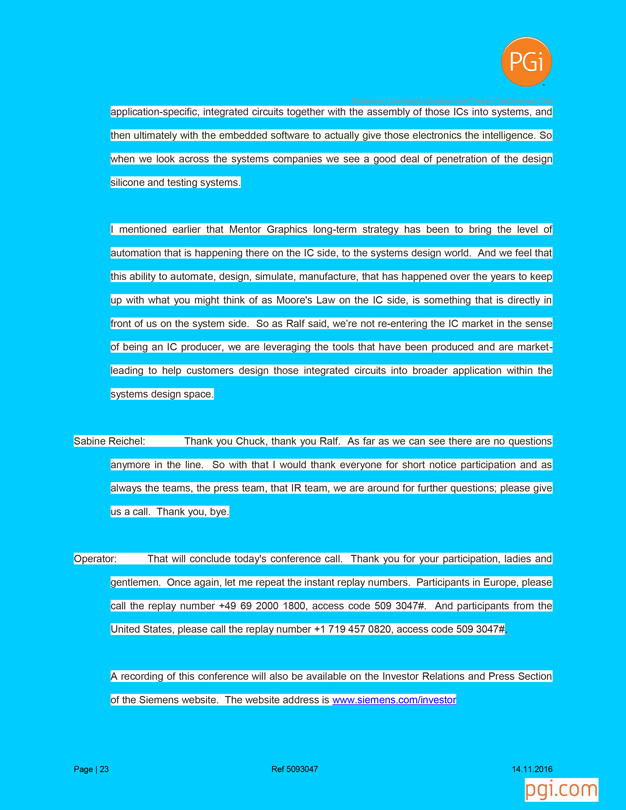
PGi
Siemens Combined Analyst and Press Conference Call
application-specific, integrated circuits together with the assembly of those ICs into systems, and then ultimately with the embedded software to actually give those electronics the intelligence. So when we look across the systems companies we see a good deal of penetration of the design silicone and testing systems.
I mentioned earlier that Mentor Graphics long-term strategy has been to bring the level of automation that is happening there on the IC side, to the systems design world. And we feel that this ability to automate, design, simulate, manufacture, that has happened over the years to keep up with what you might think of as Moore’s Law on the IC side, is something that is directly in front of us on the system side. So as Ralf said, we’re not re-entering the IC market in the sense of being an IC producer, we are leveraging the tools that have been produced and are market-leading to help customers design those integrated circuits into broader application within the systems design space.
Sabine Reichel: Thank you Chuck, thank you Ralf. As far as we can see there are no questions anymore in the line. So with that I would thank everyone for short notice participation and as always the teams, the press team, that IR team, we are around for further questions; please give us a call. Thank you, bye.
Operator: That will conclude today’s conference call. Thank you for your participation, ladies and gentlemen. Once again, let me repeat the instant replay numbers. Participants in Europe, please call the replay number +49 69 2000 1800, access code 509 3047#. And participants from the United States, please call the replay number +1 719 457 0820, access code 509 3047#.
A recording of this conference will also be available on the Investor Relations and Press Section of the Siemens website. The website address is www.siemens.com/investor
Page | 23 Ref 5093047 14.11.2016
pgi.com

PGi
Siemens Combined Analyst and Press Conference Call
Page | 24 Ref 5093047 14.11.2016
pgi.com























